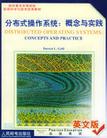分布式操作系统:概念与实践
2002-5
人民邮电出版社
人民邮电出版社
463
680000
无
本书从理论和实践两个方面,阐述了分布计算的主要概念、理论和各种成功实例,主要内容包括:内核、进程间通信、存储管理、基于对象的操作系统、分布式文件系统、事务管理与协调模型、分布进程管理、分布同步、分布计算中的安全性等。选取的实例包括:Amoeba、Clouds、Chorus、CORBA、DCOM、NFS、LDAP、X.500、NFS、RSA、Kerberos及Windows 2000等。 本书适于用作计算机科学与技术系本科高年级及研究生分布计算、分布式操作系统等课程的教材或主要参考书,也适用于在相关领域工作的科技工作者。
1. Introduction to Distributed Systems 1.1 What Is an Operating System? 1.2 What Is a Distributed System? 1.2.1 Popular Network Topologies and Features 1.2.2 ISO/OSI Reference Model 1.2.3 Distributed Computing Models 1.2.4 Distributed versus Centralized Solutions 1.2.5 Network vs. Distributed Operating Systems 1.3 What Is a Real-Time System? 1.3.1 Real-time Event Characteristics 1.3.2 Network Characteristics Affecting Distributed Real-Time Applications 1.4 What Is a Parallel System? 1.4.1 Parallel Architectures 1.4.2 Parallel Software Paradigms 1.5 Sample Distributed Application 1.6 Summary 1.7 References for Further Study Exercises 2. The Kernel 2.1 Kernel Types 2.2 Processes and Threads 2.2.1 Introduction to Multi-threaded Processes 2.2.2 Multi-threaded Process Paradigms 2.2.3 Multi-threaded support 2.3 Process Management 2.3.1 Types of Processes 2.3.2 Load Distribution & Process Migration 2.4 Process Scheduling 2.4.1 Identifying Processes for Scheduling 2.4.2 Scheduler Organization 2.5 Summary 2.6 References for Further Study Exercises 3. Interprocess Communication 3.1 Selection Factors 3.2 Message Passing 3.2.1 Blocking Primitives 3.2.2 Non-blocking Primitives 3.2.3 Process Address 3.3 Pipes 3.3.1 Unnamed Pipes 3.3.2 Named Pipes 3.4 Sockets 3.4.1 UNIX Sockets 3.4.2 JAVA Support for Sockets 3.5 Remote Procedure Calls 3.5.1 Parameter Type 3.5.2 Data Type Support 3.5.3 Parameter Marshalling 3.5.4 RPC Binding 3.5.5 PC Authentication 3.5.6 RPC Call Semantics 3.5.7 SUN's ONC RPC 3.6 Summary 3.7 References for Further Study Exercises 4. Memory Management 4.1 Review of Centralized Memory Management 4.1.1 Virtual Memory 4.1.2 Pages and Segments 4.1.3 Page Replacement Algorithms 4.2 Simple Memory Model 4.3 Shared Memory Model 4.3.1 Shared Memory Performance 4.3.2 DSM Performance Issues 4.4 Distributed Shared Memory 4.4.1 Methods for Distributing Shared Data 4.4.2 DSM Performance Issues 4.5 Memory Migration 4.6 Summary 4.7 References for Further Study Exercises 5. Concurrency Control 5.1 Mutual Exclusion & Critical Regions 5.2 Semaphores 5.2.1 Semaphore Weakness 5.2.2 Semaphore Evaluation 5.3 Monitors 5.3.1 Condition Variables 5.3.2 Monitor Evaluation 5.4 Locks 5.4.1 Taking Turns 5.4.2 Atomic Operations and Hardware Support 5.5 Software Lock Control 5.5.1 Centralized Lock Manager 5.5.2 Distributed Lock Manager 5.6 Token-Passing Mutual Exclusion 5.7 Deadlocks 5.7.1 Prevent Deadlocks 5.7.2 Avoid Deadlocks 5.7.3 Ignore Deadlocks 5.7.4 Detect Deadlocks 5.8 Summary 5.9 References for Further Study Exercises 6. Object-Based Operating Systems 6.1 Introduction to Objects 6.1.1 Object Definitions 6.1.2 Evaluation of Objects 6.2 The Clouds Object Approach 6.2.1 Clouds' Objects 6.2.2 Clouds Threads 6.2.3 Clouds' Memory Storage 6.3 Chorus V3 and COOL v2 6.3.1 The Base Layer: COOL Memory Management 6.3.2 The Generic Runtime System Layer: COOL Objects 6.3.3 The Language-Specific Runtime System Layer 6.4 Amoeba 6.4.1 Identification and Protection of Amoeba Objects 6.4.2 Amoeba Object Communication 6.5 Distributed Component Object Model (DCOM) 6.5.1 Monikers 6.5.2 Remote Method Calls 6.5.3 Garbage Collection 6.5.5 DCOM Security Policies 6.6 CORBATM Overview 6.6.1 CORBA's ORB 6.6.2 CORBA Object Adapters 6.6.3 CORBA Messaging 6.6.4 CORBA Compliance 6.6.5 CORBA to COM Mapping 6.7 Summary 6.8 References for Further Study Exercises 7. Distributed Process Management 7.1 Distributed Scheduling algorithm Choices 7.1.1 Level of Scheduling 7.1.2 Load Distribution Goals 7.1.3 Scheduling Efficiency Goals 7.1.4 Processor Binding Time 7.2 Scheduling Algorithm Approaches 7.2.1 Usage Points 7.2.2 Graph Theory 7.2.3 Probes 7.2.4 Scheduling Queues 7.2.5 Stochastic Learning 7.3 Coordinator Elections 7.4 Orphan Processes 7.4.1 Orphan Clean Up 7.4.2 Child Process Allowance 7.4.3 Process Version Numbers 7.5 Summary 7.6 References for further Study Exercises 8. Distributed File Systems 8.1 Distributed Name Service 8.1.1 File Types 8.1.2 Location Transparency 8.1.3 Global Naming & Name Transparency 8.2 Distributed File Service 8.2.1 File Variations 8.2.2 File Modification Notification 8.2.3 File Service Implementations 8.2.4 File Replication 8.3 Distributed Directory Service 8.3.1 Directory Structures 8.3.2 Directory Management 8.3.3 Directory Operations 8.4 NFS TM 8.4.1 NFS File Service 8.4.2 NFS Directory Service 8.4.3 NFS Name Service 8.5 X.500 8.5.1 X.500 File and Name Service: The Information Model 8.5.2 X.500's Directory Service: The Directory Model 8.6 Summary 8.7 References for Further Study Exercises 9. Transaction Management & Consistency Models 9.1 Transaction Management Motivation 9.1.1 The Lost Update 9.1.2 Retrieval Disparity 9.2 ACID Properties of a Transaction 9.3 Consistency Models 9.3.1 Strict Consistency Model 9.3.2 Sequential Consistency Model 9.3.3 Casual Consistency Model 9.3.4 PRAM Consistency Model 9.3.5 Processor Consistency Model 9.3.6 Weak Consistency Model 9.3.7 Release Consistency Model 9.3.8 Lazy Release Consistency 9.3.9 Entry Consistency Model 9.4 Two-Phase Commit Protocol 9.4.1 Prepare to Commit Phase 9.4.2 Commit Phase 9.5 Nested Transactions 9.6 Implementation Issues for Transactions 9.6.1 Premature Reads & Writes 9.6.2 The Domino Effect of aborts 9.6.3 Ensuring Recoverability 9.7 Summary 9.8 References for Further Study Exercises 10. Distributed Synchronization 10.1 Introduction to Global Time 10.2 Physical Clocks 10.2.1 Obtaining an Accurate Physical Time 10.2.2 Synchronizing Physical Time 10.2.3 Centralized Physical Time Services 10.2.4 Distributed Physical Time Services 10.3 Network Time Protocol (NTP) 10.3.1 NTP Architecture 10.3.2 NTP Design Goals 10.3.3 NTP Synchronization Modes 10.3.4 Simple Network Time Protocol(SNTP) 10.4 Logical Clocks 10.4.1 Happen-Before Relationship 10.4.2 Logical Ordering 10.4.3 Total Ordering with Logical Clocks 10.5 Summary 10.6 References for Further Study Exercises 11. Distributed Security 11.1 Cryptography & Digital Signatures 11.1.1 Symmetric Encryption 11.1.2 Asymmetric Encryption 11.2 Authentication 11.2.1 Certificate Lists 11.2.2 Centralized Certificate Distribution Center 11.3 Access Control(Firewalls) 11.3.1 Packet Filtering Gateways 11.3.2 Proxy Services 11.3.3 Firewall Architectures 11.4 Summary 11.5 References for Further Study Exercises 12. CASE STUDY: Windows 2000TM 12.1 Overview: Windows 2000 Design 12.2 Kernel Mode Overview 12.2.1 Kernel Objects 12.2.2 Hardware Abstraction Layer(HAL) 12.2.3 Device Drivers 12.2.4 The Executive 12.3 Plug and Play 12.4 NT Files System in Windows 2000(NTFS) 12.4.1 Access Control Lists(ACLs) 12.4.2 Reparse Points 12.4.3 Storage Management 12.5 Active Directory 12.5.1 NameSpace 12.5.2 Change Journal for Replication and Scalability 12.5.3 Microsoft Index Server and HTTP Support 12.6 Microsoft Management Console(MMC) 12.7 Cluster Service 12.7.1 Cluster Service Overview 12.7.2 Cluster Abstractions 12.7.3 Cluster Service Architectures 12.7.4 Cluster Service Deployment to Applications 12.8 Windows 2000 Security 12.8.1 Security Configuration Editor 12.8.2 Encrypting file System 12.8.3 Microsoft Security Support Provider Interface 12.9 HYDRA-A Thin Client 12.10 Summary 12.11 References for Further Study Exercises Appendix A. Surgical Scheduling Program List of Acronyms Glossary of Terms Bibliography Index

无